Flush mechanism for the toilet: device, principle of operation, an overview of various designs
Without a toilet in the bathroom, to call a cottage or an apartment comfortable, the language does not turn. Agree, this statement is difficult to refute. There are a huge number of models of this plumbing. But they do not differ in the special complexity of the internal structure, the principle of operation of all modifications is the same.
If there is a breakdown with water supply, then most likely it will be necessary to repair the toilet drain mechanism - it is the drain system that most often fails with this plumbing fixture. We are ready to help you quickly deal with this problem.
In this material, we have collected and summarized information about the main types of toilet cisterns, breakdowns that may occur, and how to eliminate them. For clarity, the materials are accompanied by thematic photos and videos.
The content of the article:
Design and types of toilet tanks
The drain tank is an integral and one of the main elements of the toilet. This is a container with two or three technological holes for supplying / draining water and a lid.
First, water is drawn into this tank, and then, when the button is pressed, it is drained into the toilet bowl to flush sewage into the sewer.
There is nothing particularly interesting or complicated in the design of the toilet flush cistern. Inside only a couple of mechanisms.
One provides the supply and shutoff of the supplied water at the moment when it fills the tank to the desired level, and the second is designed to directly drain the accumulated moisture into the bowl.
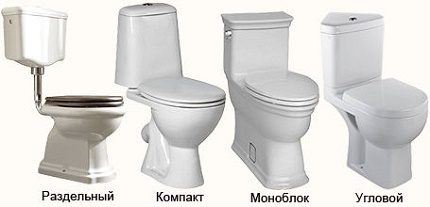
Drain tanks according to the material of manufacture are divided into three types:
- Ceramic (faience) - reliable and cheap classics.
- Metal - Not very aesthetically pleasing, but durable option.
- Plastic (from polyethylene) - light in terms of weight and installation blocks.
According to the method of attachment and location, they are:
- low located - are installed directly on the toilet bowl;
- high up - hung on the wall or located inside it in the installation block.
Separate toilets, in which the tank is separated from the bowl, have a drain pipe for water overflow. And the higher their storage capacity is suspended, the more powerful the water pressure is obtained from it.
Their only drawback is the not very presentable appearance of the tank, located high above the floor. Therefore, most often in domestic toilets you can see models of toilets with tanks placed directly on the edge of the bowl. They are more compact and aesthetic.
Water supply system options
The internal mechanism for feeding water to the toilet flush tank includes:
- crane (float valve);
- plastic float;
- leverage.
Water is supplied to the drive through an opening in its housing on the right, left, or bottom. With the lateral method, the float is fixed at the end of the horizontal arm, which is connected to the ball valve.
And with the bottom version, the float is connected with a vertical rod located in the inlet pipe.
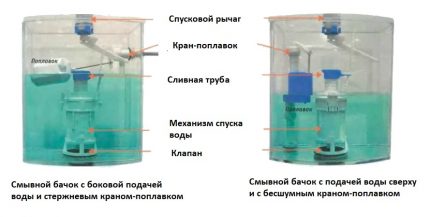
The basic principle of the mechanism for supplying water to the toilet flush tank is extremely simple. As a result of the emptying of the drive, the float, which is kept on the water due to the air inside, falls after the liquid level decreases.
Once below, he opens the valve of the valve on the water supply, and as the tank is filled, it rises again and closes the water supply.
Everything in the work of this mechanism is based on the laws of physics. There is no electronics in its design, which significantly reduces the risk of breakage. A situation is possible when there is too little or too much water in the toilet bowl.
Then the float needs only to be adjusted so that the filling of the tank becomes consistent with the desired parameters. But if the levers broke, then the float system will have to be changed.
Varieties of drainage mechanisms
If necessary, flush the unnecessary from the toilet, we just press the button on the tank. Everything else happens by itself. Inside, the water release mechanism is activated, opening the drain valve.
As a result, the water stream rushes into the bowl and flushes everything into the sewer system.
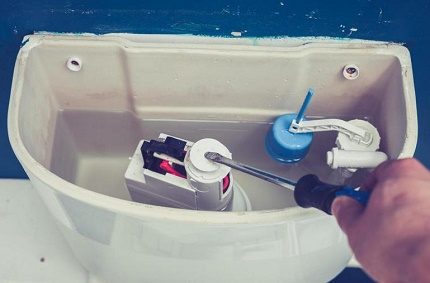
The drain device is driven by:
- by pressing a button;
- pressing the lever;
- jerking a chain (rope).
Tanks are available in different shapes and designs. However, most of them are standardized for a volume of 6 or 4 liters and have typical hole sizes for drain valves.
There are a lot of mechanisms of water descent, different in design. But if the one in the tank breaks, it can be replaced with a new one without any problems.
Our other article contains information about the device of a spillway device - tank fittings.
The simplest version of the drain siphon is a “pear” that resembles a rubber plunger in shape. Under the weight of the water, it is firmly pressed against the drain hole and overlaps it.
And when you press the lever, the “pear” rises due to mechanical force and releases water into the toilet bowl.
Then, as the tank fills, it becomes heavier and lowers back onto the saddle, again closing the drain hole.
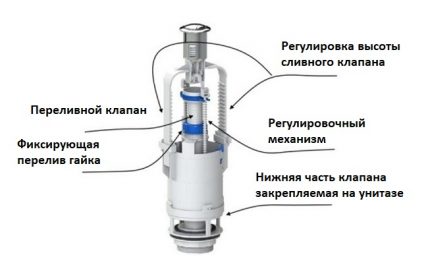
In the event of a breakdown of the water supply device, an overflow is provided in the design of the drain mechanism of the toilet bowl.If a certain level is exceeded, water will overflow into this pipe and go straight through the bowl to the sewer.
The most common damage to the drain tank is discussed in our article: Do-it-yourself toilet drain tank repair
Everything is arranged in such a way that it will not be able to pour out of the tank by definition. When triggered, such a transfusion will lead to an increase in the counter readings of the HVS, but will avoid a flood.
Structurally, the discharge of water in the toilet itself is either horizontal or circular. The first classic option involves the flow of water in a continuous stream from one side of the bowl, and the second - the formation of jets round from its outline.
Horizontal descent is cheaper to perform, but uneconomical and worse wash sanitary ware. The circular analogue is better in all operational parameters.
However, with a high degree of water hardness, its small holes may become clogged, which will lead to a decrease in the number of jets.
The principle of operation of the dual-mode drain
Modern models of drain tanks are equipped with a dual drain button. This is a tribute to water saving.
Such devices are designed for two modes of operation:
- standard - to dump into the bowl of the entire tank (4 or 6 liters);
- half - pouring only part of the volume (2 or 3 liters).
Such a system is more economical in terms of water consumption. But she is also more moody in terms of tuning and repair. The number of internal elements in it is increased, which means that the risk of breakdown of this device also increases.

In addition to the dual version, the button for the dual-mode drain mechanism can be one. In this case, the discharged volume of water depends on the pressure of the person on the lever.
While the button is pressed, the drain hole remains open, and after it is released, it returns up and at the same time the drain is blocked.
Selection and repair of tank mechanisms
Choosing a toilet tank, you have to compromise between the price of the drain device and its quality. The design of metal elements is more durable, but also costs more than a fully made of plastic.
The water supply from below is less noisy lateral, however, it will have to be overpaid for a lot. The side mounted mechanism is simpler in design and cheaper.

The float is made in the form of a hollow sealed cylinder or an inverted glass. The first option is more reliable, but when holes appear in the plastic walls, you can forget about the tightness. Water seeping through the holes will inevitably lead to the failure of the float.
The principle of its operation is based on the presence of air inside. When punctures appear in the plastic, it must be replaced immediately.
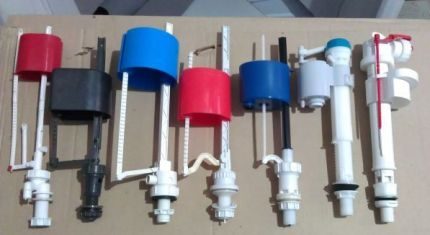
A problem with leakage may be due to contamination of the bleed valve. Just between the rubber element and the saddle, dirt accumulated in the form of rust from old pipes or sludge.
In this case, you don’t have to change anything, just remove the cover, raise the cuff and clean everything under it with a rag. But if the rubber is frayed or aged, then it will definitely need to be replaced.
You may also be interested in information on how to replace gasket between the tank and the toiletreviewed in our article.
Before installing the valve inside the tank, it must be mounted on the bowl.The design and layout of the toilet flush cistern are such that after mounting the internal mechanisms it will be problematic to reach the coupling bolts.
First, you should install and mount the ceramic tank on the edge of the toilet bowl, and only then install all the devices for supplying / lowering water in it.
Repair of the float crane is carried out in the following order:
Water level adjustment
If water is supplied from the side, then the maximum of its level in the tank is regulated by changing the length of the spoke. It is at its end that a float is fixed. In old and many new models, the role of this lever is played by a thick brass wire.
You just need to bend it in the middle so that the float moves down or up. The higher it ends up, the larger the tank will be filled.
However, now more and more often metal is being changed to plastic. But it will not work to bend the plastic elements at the right angle, they can simply break.
In this design, the float must be shifted along the axis of the plastic studs, increasing or decreasing the lever arm. The farther the float device is from the valve, the more water will flow into the tank.
The float arm in the toilet models with a lower water supply is located vertically. Here, the water level is much easier to regulate.
The float element must simply be moved up / down and fixed at the desired height with the clamps or nuts provided for this.
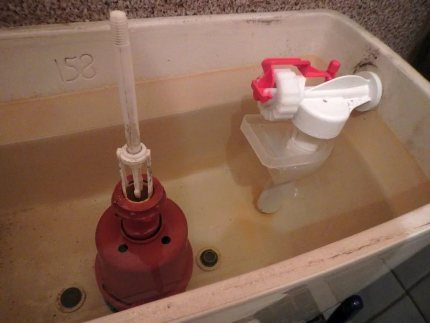
The main problem when making the adjustment is not to change the position of the float, but to remove the lid of the toilet bowl. A drain button is attached to it, which in many models is rigidly connected to the drain mechanism.
In order not to break anything, disassemble this design with extreme caution. First you need to carefully unscrew the clamping ring of the button. And only after that it will be possible to safely shift the lid.
Do you still have an unfortunate breakdown of the toilet lid? You can try to fix it with your own hands. AT this article we walked through step by step how to do this.

Almost all the working elements of the mechanism of the drain tank in the toilet are now made of plastic, not metal. Because of this, they often break.
In plumbing stores, both ready-made drain and supply designs, as well as their individual components for repair, are sold. In some situations, it is cheaper to replace only part of the device, while in others it is easier to completely replace the entire assembly.
You may also be interested in reading about how to disassemble the drain tankso as not to accidentally damage anything.
Photo-instructions for replacing the device
The following photo instruction will help the home masters who want to completely change the damaged drainage device:
To replace the drain valve, you will need to dismantle the tank.
To eliminate unnecessary pollution of the premises and provide ourselves with a convenient place to work, we will close the most suitable area for this with old newspapers or rags.
The process of replacing the drain device is simple, but requires accuracy and strict adherence to the sequence of steps.
Conclusions and useful video on the topic
We offer useful videos to better understand the mechanism of the drain tank.
The technology for repairing the toilet drain unit:
Water does not reach the tank - what can be done:
Ways to eliminate drain tank leaks:
The flush device in the toilet is not too abstruse and complicated design. The mechanism consists of two working elements - one for supplying and controlling the water level, and the second for its direct flow into the bowl.
There are several types of these devices, each with its own pros and cons. But the essence of the work is the same in all cases. At the same time, it’s easy to install, adjust and repair them with your own hands.
Most issues can be dealt with without the involvement of a plumber. Only a wall-mounted installation can cause problems - for installation and toilet installation repair it is better to attract experienced craftsmen.
Are you familiar with the arrangement of the drain mechanism of various types of tanks? Or are you using a hanging toilet bowl whose cistern is hidden in the wall structure? Perhaps you encountered any breakdown of the drainage system and fixed the problem on your own? Please share your experience with our readers by leaving your comments under this article.

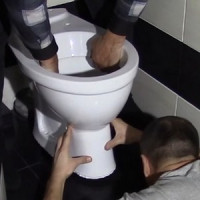 Do-it-yourself toilet installation: features of mounting toilet bowls of various designs
Do-it-yourself toilet installation: features of mounting toilet bowls of various designs  Toilet chopper pump: device, principle of operation and installation rules
Toilet chopper pump: device, principle of operation and installation rules 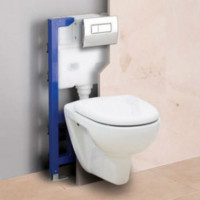 How to choose a toilet installation: overview of designs and tips before buying
How to choose a toilet installation: overview of designs and tips before buying 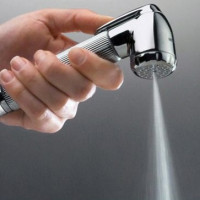 Hygienic shower for the toilet: a comparative overview of the designs and the nuances of the installation
Hygienic shower for the toilet: a comparative overview of the designs and the nuances of the installation 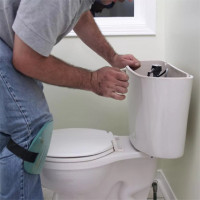 How to disassemble the toilet flush tank: instruction on working with various designs
How to disassemble the toilet flush tank: instruction on working with various designs 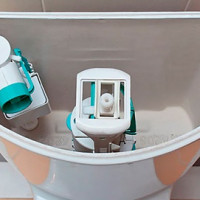 Setting up the toilet fittings: how to properly adjust the spillway
Setting up the toilet fittings: how to properly adjust the spillway  How much does it cost to connect gas to a private house: the price of organizing gas supply
How much does it cost to connect gas to a private house: the price of organizing gas supply  The best washing machines with dryer: model rating and customer tips
The best washing machines with dryer: model rating and customer tips  What is the color temperature of light and the nuances of choosing the temperature of the lamps to suit your needs
What is the color temperature of light and the nuances of choosing the temperature of the lamps to suit your needs  Replacement of a geyser in an apartment: replacement paperwork + basic norms and requirements
Replacement of a geyser in an apartment: replacement paperwork + basic norms and requirements
It is water meters that make it look for more reliable mechanisms for toilets. The hosts learned to count money. Such a simple design of a float, tap and valve, and at the same time gives in the end a malfunction, which you will not immediately notice. At first, the flow will be constant, but hardly noticeable, drip. Then, if you do not intervene and repair in a timely manner, the process will inevitably intensify.
I agree with Oksana, it was because of the water meter that I decided to check my toilet. And it turned out that it really was leaking. Settled this issue on their own, without the intervention of a plumber. The toilet flush device - the design is nowhere simpler and you can fix it yourself. Therefore, I recommend often to look into their “designs”, especially for those who already have old toilets, they have the ability to leak due to the fact that the plastic of which the device itself is made is already out of date.
Thank you so much for the video. Everything is very clear. Is it possible to turn the fasteners in the toilet tank through which water flows into the toilet itself? The reason for the question: the tank is narrow, and the float touches the device that supplies water.
Olga, now there are flat floats on sale with the same 6mm bore. Slowly turn the old bobber and pull it down at the same time (do not forget to turn off the tap for water to enter the tank). A new float in the same way, only with an effort up.
Our toilet has an excellent mechanism. As a plumber installed the toilet, so 3 years with him the order.